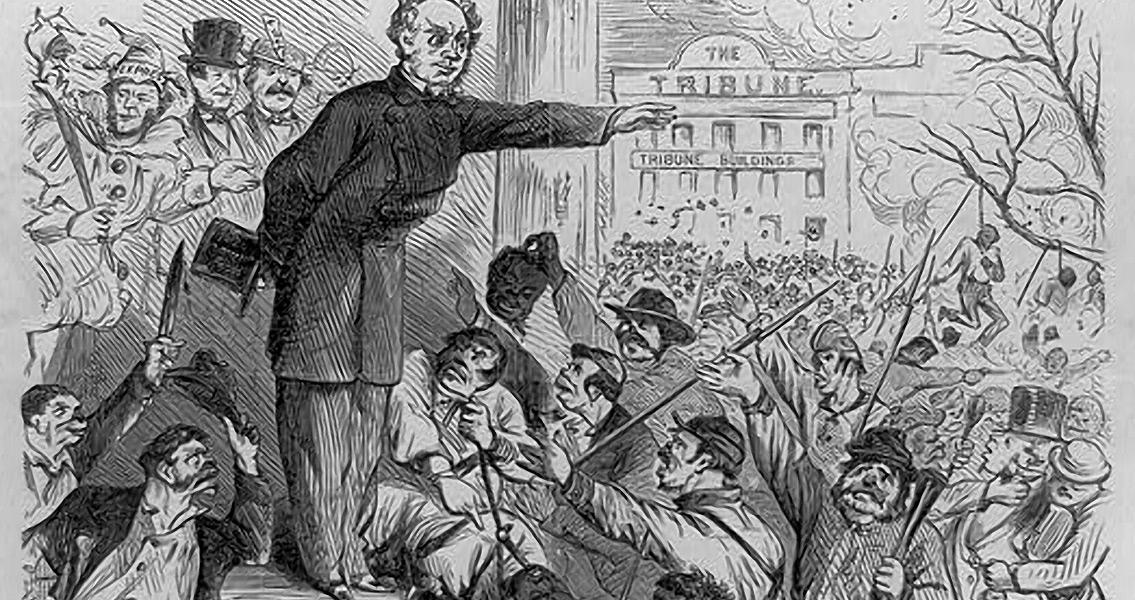<![CDATA[The largest ever civilian insurrection in the United States began on 13th July, 1863, in New York City. Initially started as a protest against the first mandated conscription laws in the country's history, the protests soon escalated into terrifying violence, revealing a much broader dissatisfaction among the city's population. Passed in March 1863, the USA's first draft law was in response to the Union's forces becoming perilously depleted as a result of desertion, death and injury to its soldiers. Ordered by the Lincoln Administration and approved by Congress, the new draft was intended to reinforce the ranks of the Union armies. The draft was unpopular throughout the Northern US States, but particularly so in New York City, where opinion on the Civil War was markedly divided. The fact that African-Americans were exempt from the draft, as they were technically not US citizens, and that the wealthy could become exempt through paying a fee, made the draft increasingly seem like an act of aggression towards New York's white, working class population. Prior to the riots of 13th July, New York City was already on the precipice. Many felt that the Civil War was only being fought to benefit the rich merchants of the city. A labour demonstration earlier in the year had turned violent, reinforcing this sense of a growing separation between the richest and poorest in the city. Racial tensions had also exploded in a protest by white dock workers who refused to work alongside African-Americans. The scarcity of jobs and a growing rich poor divide saw white immigrants to the city come into direct competition with African-Americans for jobs, fueling tension between the two groups. Aside from the exemption offered to rich New Yorkers, great care was taken to make the draft process look fair. Assistant provost marshals had visited factories in the months before July to compile a list of eligible white men aged between 20 and 45. From 11th July these names were written on sheets of paper which were drawn at random by a blindfolded clerk, essentially creating a lottery to decide military service. The first day of the draft went by peacefully, but on the morning of the 13th July a massive group of protesters gathered outside the Provost Office where the day's draft was scheduled to take place. Many of the protesters were armed, and a large number had arrived not simply to protest against the intrusion into their lives the draft represented, but broader concerns about the difficulties they faced in finding jobs. A shot fired into the air at 10:30am caused the protesters to push past the barricade of police to force their way into the building. Hugely out numbered, the police and organisers fled as the mob stormed the office and set about destroying anything associated with the draft. Unable to open the safe which contained the list of names, the mob burnt the whole building down. Quickly, what had started as a protest against the draft escalated into something far more terrifying. The mob launched a wave of violence and destruction, Police Superintendent John Kennedy was horrifically beaten, to the extent that his colleagues could no longer recognise him when he was pulled to safety in a local police station. An orgy of destruction followed with stores being looted and vandalised. The mob then descended on the Colored Orphan Asylum, a refuge for some 200 orphaned African-American children. The teachers and carers at the orphanage saw the approaching mob and quickly evacuated the children to safety. The building was wrecked, looted and then torched. One child, who had been left behind during the evacuation and was found hiding under a bed, was murdered by the rioters. The attack on the orphanage marked the point when the racial tension behind the New York insurrection became abundantly clear. Over the next three days the chaos and destruction continued as authorities struggled to restore order in New York City. Stores, hotels, and newspaper offices were attacked and vandalised. The homes of the wealthy were broken into and their property destroyed. A consistent theme throughout was this fixation with destruction, rather than stealing the property of the affluent. African-American men were the biggest targets of the violence, highlighting that the protest against the draft had been used as a gateway to vent dangerous frustrations. Close to a dozen black men were beaten and lynched by the end of the rioting, with newspapers carrying harrowing images of three African-American men hanging from a telegraph pole with a mob below. The arrival of 4,000 troops who had just fought at the Battle of Gettysburg, combined with appeals by church leaders for the largely Irish Catholic mob to stop, eventually brought the chaos in New York to an end on 16th July. Estimates range from 115 to nearer 500 for the total number of deaths caused in the four days of rioting. Rarely covered in mainstream histories of the US Civil War, the draft riots and subsequent descent into near anarchy highlight how divided the North was during the conflict. It is not unusual for a war to be unpopular with the ordinary men and women who fight in it, especially if they are forced into an active role through conscription. The events started on 13th July 1863 however, revealed something far more sinister: brewing racial tension and resentment of the wealthy in the biggest city in the Union at the same time its soldiers were fighting to abolish the institution of slavery in the southern states. ]]>
New York City Draft Riots
